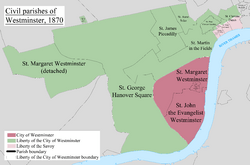Close of the Collegiate Church of St Peter facts for kids
| Close of the Collegiate Church of St Peter | |
 |
|
| Geography | |
| Status | Extra-parochial area (until 1858) Civil parish (after 1858) |
| 1881 area | 9 acres (0.036 km2) |
| History | |
| Abolished | 1922 |
| Succeeded by | Metropolitan Borough of Westminster |
Quick facts for kids Demography |
|
|---|---|
| 1881 population | 249 |
| 1901 population | 231 |
| 1921 population | 194 |
| Politics | |
| Governance | Dean and Chapter of Westminster |
The Close of the Collegiate Church of St Peter was a special area in London, England. It was like a small, separate district that included Westminster Abbey and the buildings around it. This area was also known as the Collegiate Church of St Peter.
For a long time, it was an extra-parochial area. This means it was not part of a regular church parish. Later, it became a civil parish, which is a type of local government area. It was located right in the middle of other parishes in Westminster.
What Was the Westminster Abbey Close?
The Close of the Collegiate Church of St Peter was basically the land and buildings directly linked to Westminster Abbey. It was managed by the Dean and Chapter of Westminster. This group of church leaders looked after the Abbey and its surrounding properties.
A Special Area in London
This special area was like an island within the larger parishes of Westminster St Margaret and St John. It had its own rules and ways of being managed. This made it unique compared to other parts of London.
How the Area Changed Over Time
Over the years, the way the Close was managed changed.
- In 1875, it joined the St George's Poor Law Union. This was a group of parishes that worked together to help people in need.
- In 1889, the parish became part of the new County of London. This was a big step in how London was governed.
- Then, in 1900, it became part of the Metropolitan Borough of Westminster. This was a larger local government area.
- Finally, in 1922, the Close stopped being a separate civil parish. Its responsibilities were then taken over by the larger Westminster borough.

